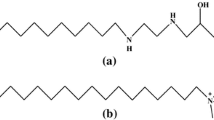Abstract.
The mixing behavior of several cationic plus anionic surfactant binary mixtures, viz., sodium dodecyl benzene sulfonate (SDBS) plus hexadecyltrimethylammonium bromide (HTAB), SDBS plus tetradecyltrimethylammonium bromide (TTAB), SDBS plus tetradecyltriphenylphosphonium bromide (TTPB), sodium dodecyl sulfate (SDS) plus TTPB, SDBS plus hexadecylpyridinium chloride (HPyCl), and SDS plus HPyCl was studied in pure water with the help of conductivity, interfacial tension, turbidity, and viscosity measurements. The mixed-micelle formation was evaluated with the help of the Clint equation and the regular solution approximation. It was observed that head-group modification had a significant influence on the nature of the mixed-micelle formation. The SDBS plus TTAB mixed micelles showed positive departure from ideality and had positive values for the regular solution interaction parameter, β. The SDS plus HPyCl mixture showed both negative and positive departures in the SDS- and HPyCl-rich regions of the mixtures, respectively, from ideality. The SDBS+TTPB mixture remained close to ideal, and the SDBS plus HTAB, SDBS plus HPyCl, and SDS plus TTPB mixtures showed synergistic behavior. The positive β value in the case of the SDBS plus TTAB mixture was not the result of antagonistic behavior, but was due to the higher value of the mixed critical micelle concentration compared to the ideal mixed cmc values in the ideal state (obtained from the Clint equation) and which was the consequence of unavailability of unlike monomers in the formation of insoluble salt owing to the neutralization of the unlike monomers with opposite polarities. The SDBS plus HTAB mixture did not show similar behavior, most probably owing to the larger size and lower charge density at HTA+ in comparison to at TTA+, which could have resulted in the former having weaker electrostatic interactions with the DBS– anion in comparison to the latter. The weaker electrostatic interactions in conjunction with the packing geometrical constraints are responsible for the close-to-ideal behavior of the SDBS plus TTPB mixture.
Similar content being viewed by others
Author information
Authors and Affiliations
Additional information
Electronic Publication
Rights and permissions
About this article
Cite this article
Bakshi, M., Sachar, S., Mahajan, N. et al. Mixed-micelle formation by strongly interacting surfactant binary mixtures: effect of head-group modification. Colloid Polym Sci 280, 990–1000 (2002). https://doi.org/10.1007/s00396-002-0717-9
Received:
Accepted:
Issue Date:
DOI: https://doi.org/10.1007/s00396-002-0717-9



